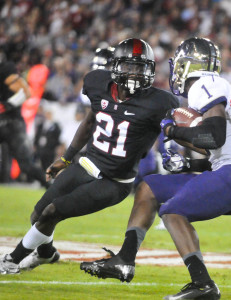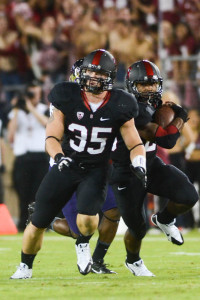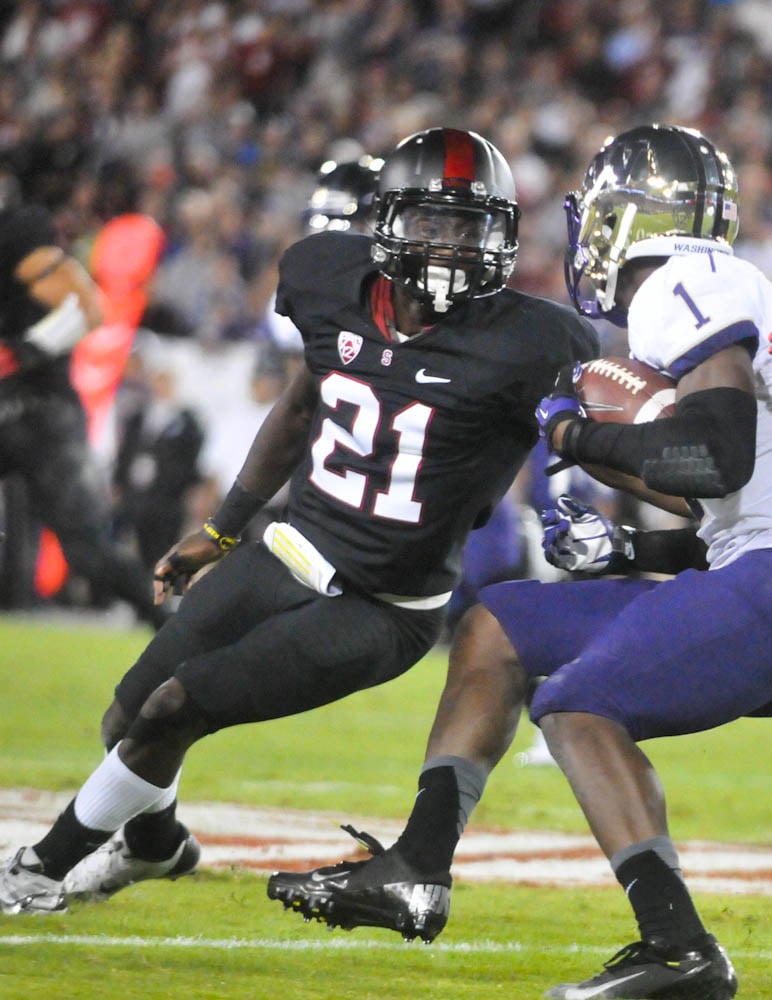It’s fourth down. The Stanford defense has just forced another punt; the Cardinal’s opponent, however, has no time to use the brief special teams interlude to catch its breath. The Sharks are coming, and they always smell blood.
Just ask Arizona State.
In their Sept. 21 matchup with the Sun Devils, the Sharks, Stanford’s punt return unit, got to Arizona State’s Matt Haack for a blocked punt that resulted in a safety, capping off a near-perfect first half for the Cardinal.
Ultimately, much of the tremendous success of the Sharks, who have allowed an average of just under four return yards per punt, can be traced back to the unit’s front line, which features a host of very recognizable names, including linebackers Shayne Skov and A.J. Tarpley.
While some successful college football programs, such as Alabama’s, use special teams primarily as a breeding ground to cultivate the talents of young, highly touted recruits, Stanford and head coach David Shaw adhere to the same guiding philosophy governing the other two phases of the game: “We’re going to put the best 11 out there.”
However, the exact special teams formula is not quite so simple. While Shaw and special teams coordinator Pete Alamar utilize many offensive and defensive stars on special teams units, they also recognize that using special teams provides a unique opportunity to give younger players the chance to earn valuable game experience early in their careers.

While there may appear to be an inherent conflict between putting the “best 11” on the field versus giving younger players an opportunity to shine, Alamar notes that Stanford has developed a system to balance the two goals. In particular, the coaching staff uses a core group of two or three veteran star players as anchors on each special teams unit; then the coaches fill in the remaining spots with younger players, who are typically athletic enough to see the field, but may not have a full grasp of the Cardinal’s complex offensive and defensive schemes quite yet.
“The balance is to find the best 11 you possibly can knowing that you’re going to use your starters in moderation. You’re going to plug in the best players at those spots that you can…You know you’ve got these two or three guys that you’re going to build around and who are the best guys now that you can put in the other spots.”
Currently, freshman wide receiver Francis Owusu perfectly fits Stanford’s special teams mold. Although Owusu has only seen a handful of snaps on offense, he has seen significant action on the kickoff coverage team, notching a couple crucial tackles against Washington. Owusu’s presence on kickoff coverage, a unit that has featured many established stars this season, including outside linebacker Trent Murphy, illustrates one of the major outcomes of Stanford’s special teams philosophy: the mixing of younger players, older players and everything in-between.
Furthermore, Shaw notes that the presence of veteran stars on special teams serves not only to anchor the individual units, but also to build players’ NFL resumes.
“It helps them on the next level. One of the questions the scouts ask is, ‘Has he played on special teams?’” Shaw said. “Usually those first couple years in the NFL, that’s where you start, too.”
Shaw also added that he doesn’t maintain any concerns that putting his best players on the field for an additional number of plays will increase the chances of injury.
“Football is football,” Shaw said. “We put them out there and let them play.”
However, Shaw did note that he would step in if he were to notice that his players were fatigued. To that end, he and Alamar decided to take Skov off of the kickoff coverage unit a few weeks ago to avoid overextending the star linebacker.
Moreover, much of Stanford’s special teams’ success this season stems from the ability of Shaw and his staff to instill a strong understanding of the tremendous value of special teams in their players.
“Special teams is just as big as offense and defense,” said junior wide receiver and kickoff returner Ty Montgomery. “As you see from the Washington game, getting points on special teams or big changes in field position is huge and it can really change the game.”
Montgomery’s performance returning kickoffs accounted for much of the team’s game-changing special teams plays against the Huskies. On the season, Montgomery, with the aid of a talented cast of blockers on the kickoff return contingent, has already tallied a nation-leading 683 yards on kickoff returns with two touchdowns.
“We’re a very passionate group. We take special teams just as seriously as offense and defense,” said junior nickelback and special teams star Ronnie Harris. “It’s a mentality. We love special teams just as much as we love offense and defense.”
Above all, the success of the Stanford special teams units this season ultimately boils down to the attitudes of individual players who have embraced the third phase of the game.

“We pride ourselves on [special teams],” said fifth-year senior linebacker Jarek Lancaster. “If we’re called, we want to be the person who makes the play or does the sweet block that springs it.”
This season, Lancaster has used his passion for special teams to emerge as the leader of a core group of players who do not start on offense and defense but regularly make game-altering plays as members of various special teams units. Other members of this crew of special teams leaders include Harris, senior linebacker Joe Hemschoot and fifth-year senior nickelback Usua Amanam.
Harris, who has dazzled this season on the punt coverage unit, echoed Lancaster’s remarks on the role of special teams.
“We’re a very passionate group. We take special teams just as seriously as offense and defense,” Harris said. “It’s a mentality. We love special teams just as much as we love offense and defense.”
Harris also added that punt coverage is his favorite unit to play on because of the great chemistry he has developed with his teammates on the unit, particularly punter Ben Rhyne. In fact, Harris, Rhyne and several other players often spend time after practice perfecting their timing on punt coverage.
Without a doubt, Stanford’s special teamers have made a crucial difference in every game this season. From directly affecting the final score, to providing the stars of tomorrow with valuable playing time, to instilling invaluable team chemistry and passion, the word “special” certainly fits the bill. If the old sports cliché, “Offense sells tickets, but defense wins championships,” bears any truth, then special teams might be the key to building dynasties. If this season is any indication, the Stanford football program is well on its way.
Contact Vihan Lakshman at vihan ‘at’ stanford.edu.
